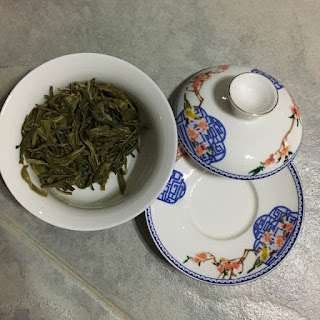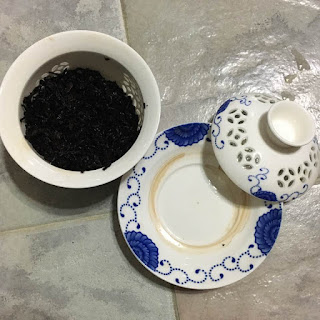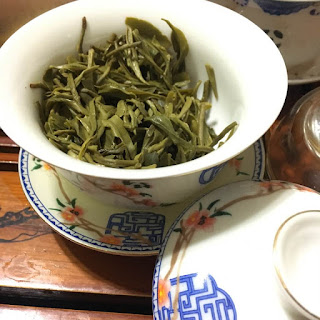This tea blog is still really small but I’m really happy to have a guest post today! My Chinese tea shifu, Cherine, wrote a really great post about Gaiwans recently and she agreed to share it here! It’s not something that I have much experience with, but her post makes me want to go out and get one for myself.
My Gaiwans
Lately, I’ve been very into using Gaiwans for my tea. My first Gaiwan was gifted to me by my dad’s client. He got me an entire tea set, and it took me a looongggggg while to start using it because it looks so elegant and pretty and I didn’t want to risk breaking anything.
It has a pretty lotus print – an epitome of elegance in Chinese designs:
The lid and saucer have the same prints:
My other 2 Gaiwans are from my recent work trip to China. I didn’t manage to get more because I was traveling alone and didn’t think I could manage with carrying so fragile stuff at once. I learnt this the hard way during a trip to Japan.
This one has peach blossoms painted on it! It costs about SGD 6:
 |
| In the bowl is my Qing Ming green tea! I made one brew in the afternoon before rushing off to work |
There’s a poem on one side:
And more peach blossoms on the other!
The last Gaiwan I have has the same design as my teapot!
There’s my yearless aged puer. I call it that because my dad bought it from his friend but didn’t ask for the year. It’s a really good puer that looks a lot like kopi o, and it doesn’t taste bitter even if I accidentally delay decanting it. There’s also zero fishy taste and I’ve managed to steep it 15 times without too much loss of taste!
 |
| The side view, with these deceiving transparent holes that confused many people like how my teapot did |
Why I prefer Gaiwans
I now prefer gaiwan to teapots because:
1) It’s easy to calculate the amount of tea leaves needed
Sometimes when I brew tea using teapots, I miscalculate the amount of leaves needed and end up using too much / too little. But with a Gaiwan, I don’t run into that problem. I usually fill the leaves up to a little higher than half the bowl, which results in a nice, balanced tasting tea.
What do I mean by balance?
2) The tea liquor has an even amount of tea being extracted from the leaves
With teapots, the tea at the top (what you get when you first pour the tea) tends to be on the thin side while the tea that gets poured last is crazy thick. I do swirl my teapot a little and pour away a little bit of tea to get rid of thinner tea before decanting into the 公道杯 (sharing cup) to try and combat this problem, but the tea liquor that comes out first still looks significantly lighter in colour. It’s almost like I’mm making cocktails L O L
With a gaiwan, I can simply use the lid to disturb the tea before I decant. That ensures that the tea liquor is even! So convenient.
3) I often drink tea alone at home, and Gaiwan makes for the perfect portion for one
I get to enjoy tea from the first steep to the last without ending up with a stomach full of tea. Of course, I can get a smaller teapot but since I have 3 gaiwans, buying yet another teapot feels redundant. The gaiwan makes 3-4 cups of tea in one steep, so even when I have my tea sessions with the dad, it’s still a good amount of tea enough for sharing.
4) Gaiwan is very very very visually pleasing
Okay, this is more of a superficial reason than a practical one! But you know in ancient dramas we often see the royalties using their personal gaiwans (without pouring into the sharing cup), like in 步步惊心 where Ruoxi made a personal gaiwan for everybody.
Chinese designs all have a lot of depth and meaning, and I believe the gaiwan is no exception. Gaiwans looks compact and adorable while looking elegant and grand. I read somewhere that the lid represents the sky, the saucer represents the earth and the bowl represents life.
And indeed water is life.
5) Gaiwan is easy to use
This overlaps with some of the previous points.
During the 醒茶 process (aka the first pour for washing the leaves), bubbles tend to appear on the surface. Some people say it is a chemical process from residual oil from the heating of tea leaves during tea production. I’m not too sure why this happens, but this article explains it. The gaiwan lid makes getting rid of bubbles easy. I also saw it mentioned on Quora that dirt tends to stick to bubbles so getting rid of bubbles kinda cleanses the tea.
This is how I get rid of the bubbles.
That being said, from what I’ve learned so far, it’s okay if there are bubbles. There won’t be any issues with dust and what not because the 醒茶 process is meant to get rid of all these anyway.
6) Gaiwans make the entire tea experience even more wholesome
Tea tasting is not limited to taste.
There’s the visual aspect (of watching tea being made) that is very calming to watch. The best tea makers are the ones that can make tea brewing look easy and smooth, without any “obstructions”.(Obstructions means that hands/arms cross the middle of the tea tray and block everyone’s view)
Gaiwan makes tea making very visible since the bowl is wider than teapot openings. We can easily see what is going on when the leaves interact with water. Sometimes the leaves roll about, sometimes the leaves spin. As the leaves absorb water and rehydrate, they slowly open and unfold into open leaves.
And then there’s the auditory aspect of the sound of water being poured, which is very relaxing. Unlike the teapot, water poured into a gaiwan sounds louder since the sounds don’t get muffled.
As for the olfactory aspect, a gaiwan obviously does its job of spreading aroma very well. Since the bowl is huge, the aroma can spread easily. Plus we can sniff from the lid! Just cover the gaiwan for a bit and then lift the lid for a quick sniff.
After getting more gaiwans, I find that I hardly use my teapots anymore. I also foresee that my gaiwan collection will expand with every work trip I take to China. I even make non-chinese teas in my gaiwan occasionally. It sounds weird, but it works!
How to use the Gaiwan
1) Pour water over the tea leaves!
Too much water?
Just lightly tip the gaiwan to get rid of excess water!
2) Tilt the cover a little to expose a gap for the tea liquor to decant
Hold the gaiwan using just your thumb, index and middle finger. Your index finger will be holding the handle of the lid, while the thumb and the middle finger hold the side rims of the bowl.
Side view:
I find holding the gaiwan this way to be very comfortable. Hot steam can escape from the side of the lid that’s facing the palm, but the steam will be direct away from it, preventing burns. However, it’s possible to scald yourself if there’s too much water, so be sure to get rid of the excess!
3) Pour!!!
Just tilt the Gaiwan a little and the tea liquor decants very easily. No scalding, no spills, no wastage, no awkward holding!
4) Keep the lid open after decanting.
This is to allow the tea leaves to dry in between steeps, especially if you are planning to leave the leaves there for a while before making the next steep. I often keep my leaves overnight if I can’t finish.
Another reason for leaving the lid open is to let the heat from the leaves escape. That way the leaves don’t get slowly “cooked” by the heat.
The same applies to teapots, I keep my lids half open between steeps to let the heat out.
That’s it on how to use a gaiwan!! I love gaiwans soooo much because it’s really so easy and convenient.
Where to buy Gaiwans
There are many of those little tea shops around Chinatown that sell gaiwans. The simple ones suitable for daily use go for about $10-ish. I sometimes buy tea a little tea shop at Sago Street and they sell tea tools as well, including gaiwans!
The other option is taobao, but then there’s a risk of breakage. I’m planning to buy some from taobao, so maybe I’ll write about that in future.
Cherine is a self-proclaimed crazy tea lady who has an impressive collection of tea and tea accessories. This tea lover can also back up her collection with her knowledge about tea and loves geeking about it with fellow tea addicts. You can find more of her tea ramblings on Dayre









